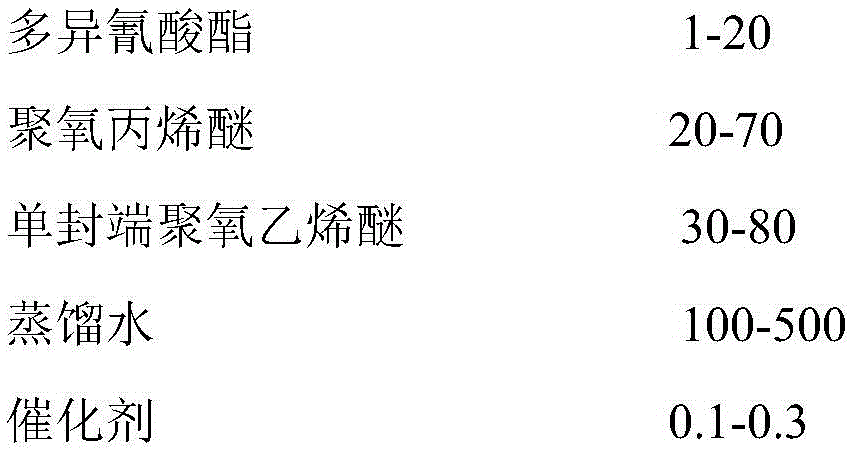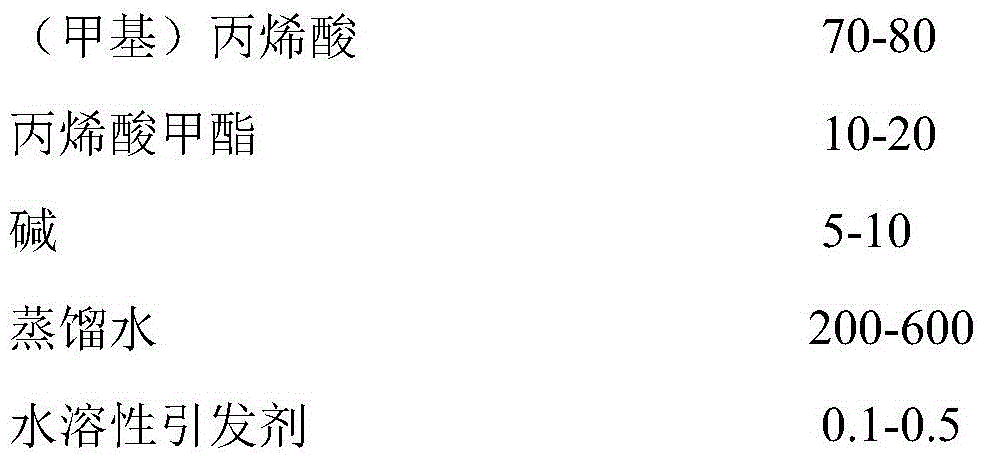A preparation method of a chrome-free tanned leather retanning agent based on hydrogen bond self-assembly
A self-assembly, chrome-free tanning technology, applied in small raw hide/big raw hide/leather/fur treatment, small raw hide/big raw hide/leather skin/fur chemical treatment, animal husbandry, etc. With the retanning function, the retanning filling performance cannot be significantly improved, etc., to achieve good retanning filling performance, good retanning filling effect, and enhanced hydrogen bond assembly effect
- Summary
- Abstract
- Description
- Claims
- Application Information
AI Technical Summary
Problems solved by technology
Method used
Image
Examples
Embodiment 1
[0042] 1. Synthesis of (meth)acrylic resin
[0043] Add 140 g of distilled water, 16.3 g of acrylic acid monomer and 2.3 g of methyl acrylate into a four-necked flask with a stirrer and a reflux condenser. Start the stirrer, stir and mix for 30 minutes; add 0.02g ammonium persulfate, continue stirring for 10 minutes, then raise the temperature to 80°C; System pH to 6.0. That is, a (meth)acrylic resin with a solid content of 10 wt % was obtained.
[0044] 2. Synthesis of Triblock Nonionic Amphiphilic Polyurethane Resin
[0045] Under the conditions of 120° C. and a vacuum of 0.09 MPa, the polyoxypropylene ether and the mono-blocked polyoxyethylene ether were distilled under reduced pressure for 120 minutes to remove moisture. Add 5.6g of polyoxypropylene ether with a molecular weight of 1000 to a four-necked bottle with a stirrer and a thermometer, heat to 80°C while stirring, add 0.0lg of dibutyltin dilaurate, stir and mix for 10min, then add 2.8g dropwise The toluene diis...
Embodiment 2
[0049] 1. Synthesis of (meth)acrylic resin
[0050] Add 140 g of distilled water, 16.3 g of methacrylic acid monomer and 2.3 g of methyl acrylate into a four-necked flask equipped with a stirrer and a reflux condenser. Start the stirrer, stir and mix for 30 minutes; add 0.02g ammonium persulfate, continue stirring for 10 minutes, then raise the temperature to 80°C; System pH to 6.0. That is, a (meth)acrylic resin with a solid content of 10 wt % was obtained.
[0051] 2. Synthesis of Triblock Nonionic Amphiphilic Polyurethane Resin
[0052] Under the conditions of 120° C. and a vacuum of 0.09 MPa, the polyoxypropylene ether and the mono-blocked polyoxyethylene ether were distilled under reduced pressure for 120 minutes to remove moisture. Add 5.6g of polyoxypropylene ether with a molecular weight of 1000 to a four-necked bottle with a stirrer and a thermometer, heat to 80°C while stirring, add 0.0lg of dibutyltin dilaurate, stir and mix for 10min, then add 2.8g dropwise The...
Embodiment 3
[0056] 1. Synthesis of (meth)acrylic resin
[0057] Add 140 g of distilled water, 16.3 g of acrylic acid monomer and 2.3 g of methyl acrylate into a four-necked flask with a stirrer and a reflux condenser. Start the stirrer, stir and mix for 30 minutes; add 0.02g ammonium persulfate, continue stirring for 10 minutes, then raise the temperature to 80°C; System pH to 6.0. That is, a (meth)acrylic resin with a solid content of 10 wt % was obtained.
[0058] 2. Synthesis of Triblock Nonionic Amphiphilic Polyurethane Resin
[0059] Under the conditions of 120° C. and a vacuum of 0.09 MPa, the polyoxypropylene ether and the mono-blocked polyoxyethylene ether were distilled under reduced pressure for 120 minutes to remove moisture. Add 5.6g of polyoxypropylene ether with a molecular weight of 2000 to a four-necked bottle with a stirrer and a thermometer, heat to 80°C while stirring, add 0.0lg of dibutyltin dilaurate, stir and mix for 10min, then add 2.8g dropwise The isophorone d...
PUM
 Login to View More
Login to View More Abstract
Description
Claims
Application Information
 Login to View More
Login to View More - R&D
- Intellectual Property
- Life Sciences
- Materials
- Tech Scout
- Unparalleled Data Quality
- Higher Quality Content
- 60% Fewer Hallucinations
Browse by: Latest US Patents, China's latest patents, Technical Efficacy Thesaurus, Application Domain, Technology Topic, Popular Technical Reports.
© 2025 PatSnap. All rights reserved.Legal|Privacy policy|Modern Slavery Act Transparency Statement|Sitemap|About US| Contact US: help@patsnap.com



